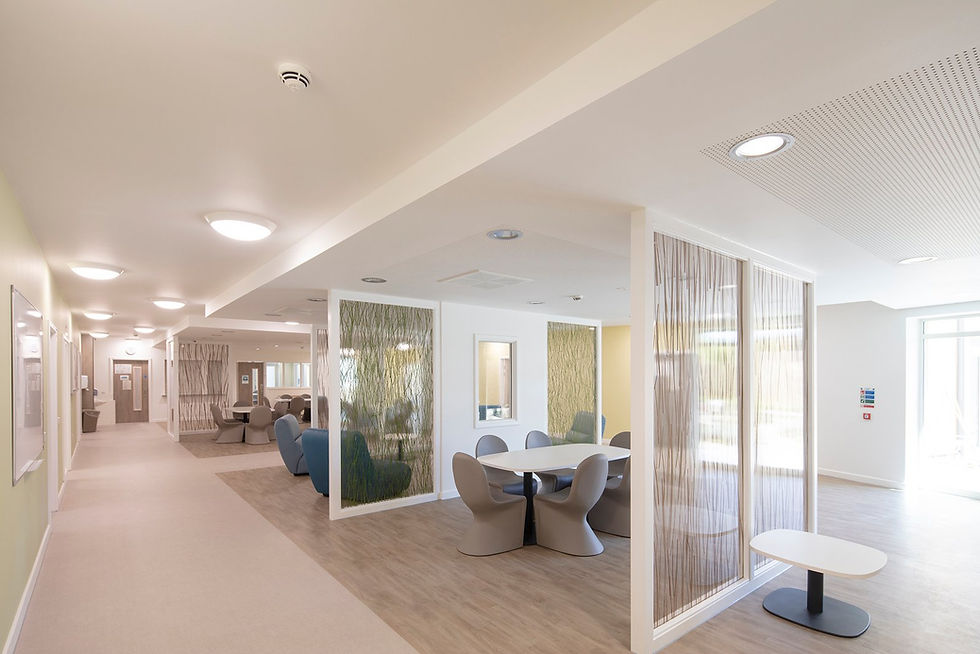Supporting a Positive Recovery in Mental Health
- Future HealthSpaces
- Apr 5, 2022
- 3 min read

A positive recovery is at the heart of every healthcare facility, particularly psychiatric hospitals treating mental health. A large part of any individual’s recovery is underpinned by the support they’re provided, but studies are constantly showing that the environment they receive it in is also critical.
While improving the treatment of mental illness remains the priority within NHS Trusts and private facilities, creating an environment that promotes a positive recovery is quickly becoming another area of focus for mental health facilities.
Creating a Therapeutic Space:
Psychiatric hospitals provide care to those suffering from severe mental illnesses. Residential treatment is offered to anyone who presents a risk of self-harm or danger to others or cannot care for themselves due to their condition.
As emotionally intelligent beings, we are all products of our environment, and as such, our mood and behaviour can be drastically affected by our surroundings. As a result, transforming the environment where treatment is provided is an indirect way to improve the patient experience and ensure patients feel at home.
The concept of improving the space that patients receive treatment in has been discussed for many years. In 1860, Florence Nightingale observed links between patients who died and their surroundings.
She noted that “darkened rooms were harmful and sunlit rooms healthful”. Responsible for kickstarting an entire field of medical studies, many of Nightingale’s pioneering principles are still relevant today.
The Impact of Colour:
Historically, psychiatric healthcare facilities were characterised by an institutional feel, lacking colour and features reminiscent of ones you’d find in a home. These settings were not conducive to the relaxed atmosphere that mental health patients need.
Qualitative studies based on interviews with patients revealed that the outdated environments could trigger stress and feelings of imprisonment and isolation. This can cause further distress to patients and make the complex recovery process that bit more challenging.
Particularly in long-stay mental health facilities, it’s crucial to create an environment that evokes a homely feeling to support a positive recovery. This can be achieved through the introduction of relaxing colours in a room.
Colour psychology is a relatively under-researched field, but in general, it’s understood that warm colours evoke feelings of happiness, optimism and energy. In contrast, cool colours can have a calming effect.
Yewdale’s range of Kestrel® anti-ligature blind systems come in a wide range of colours to help brighten a room without creating any ligature risks. While the selection of colours cannot be viewed as a form of therapy for mental illness, colours could help create a positive atmosphere for patients and make them receptive to treatment.
Safety is Paramount:
Creating a home from home environment in mental health facilities is particularly challenging because healthcare staff must be mindful of the risks that different items present. A vast range of objects found in homes could be harmful to patients and staff when misused. As a result, home comforts are limited, especially in patients’ rooms where constant observation isn’t possible.
Many NHS Trusts are introducing magnetised equipment to provide individuals with the comfort of home. Due to the magnets used, accessories including shelf sets, wipe boards, and mirrors can be added to patients’ rooms without posing a ligature risk.
In psychiatric hospitals, it may not be safe to have a standard bathroom door fitted to the ensuites. However, providing patients with privacy is crucial to ensure they are comfortable and don’t feel under constant observation.
Anti-Ligature Door:
One innovative product that has been well-received by NHS mental health facilities is the UK’s first safe door, designed for use as an ensuite door. Constructed from soft foam, Yewdale’s SafeDoor features magnetic hinges, which allow the door to separate from the frame under an excessive load.
Not only does this foam door provide 100% fail-safe anti-ligature functionality, but its external surface can be printed on, allowing healthcare providers to introduce some vibrance into patients’ rooms. Healthcare professionals can choose from a wide range of colours, or source an image to be printed on the door, such as a calming ocean scene or relaxing waterfall.
By introducing vibrantly coloured blinds and a safe door with a visually-pleasing print on it, a service user’s private room can be transformed into a space they may feel more comfortable in. Replacing standard blinds and ensuite doors with magnetised alternatives such as these also helps to create a safer living space without ligature risks.
Summary:
Creating a homely, patient-friendly environment in psychiatric hospitals can help to provide a better patient experience by elevating mood, reducing aggression and feelings of isolation. Healthcare facilities are adopting innovative products to improve safety and create a better therapeutic space that supports a positive recovery.


